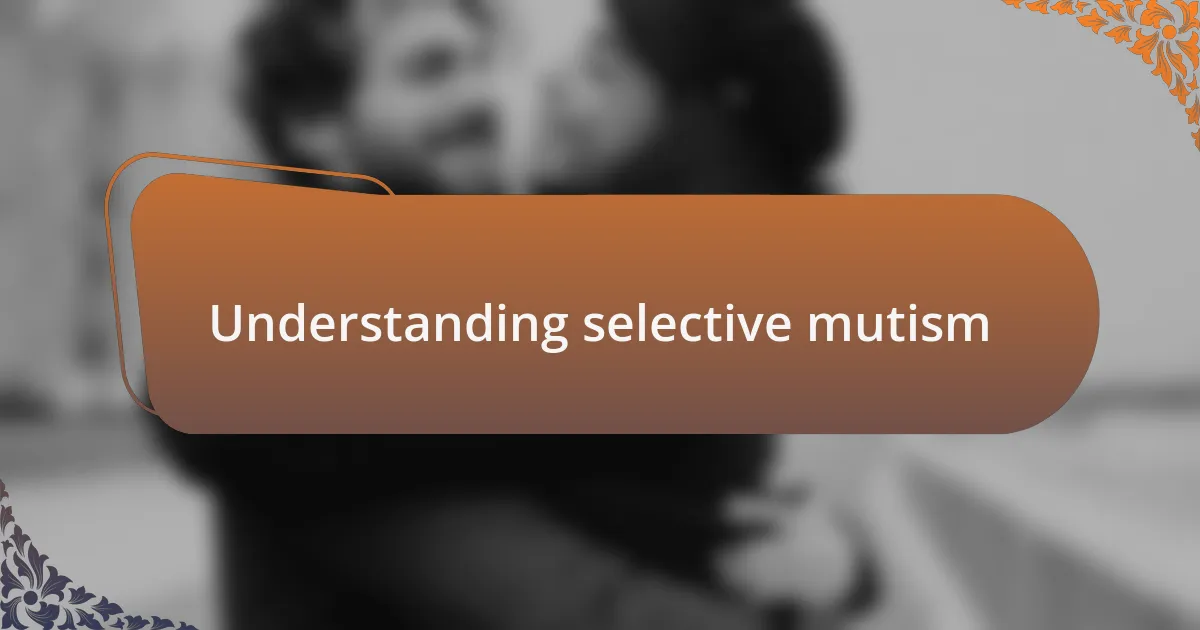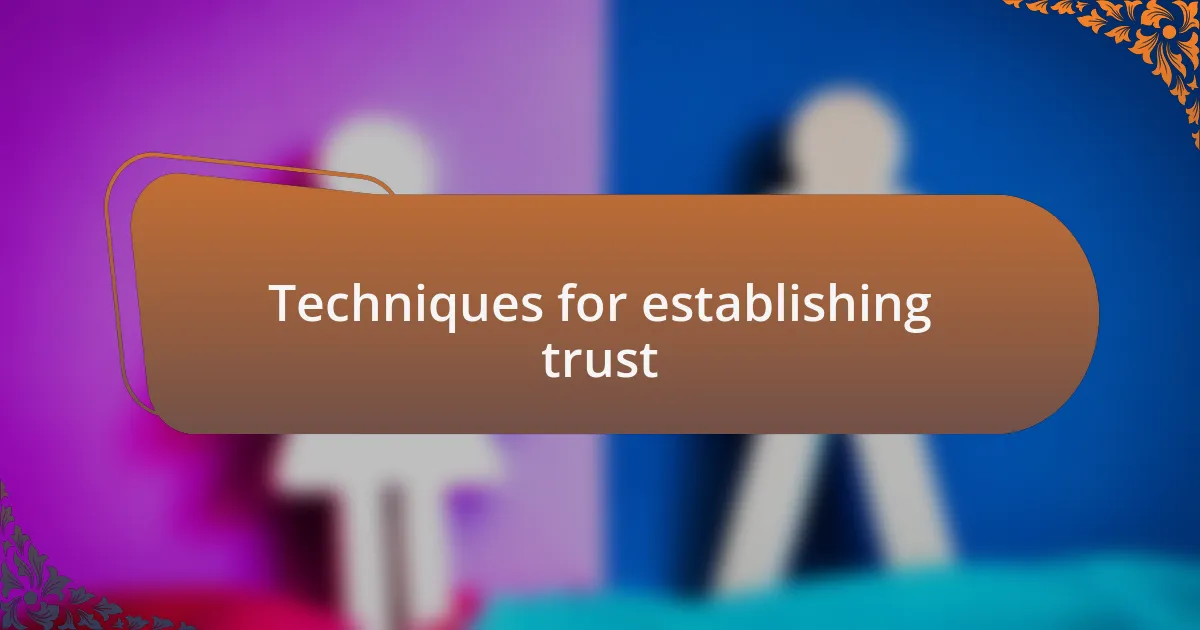Key takeaways:
- Selective mutism is an anxiety disorder where children can speak in some environments (e.g., home) but struggle in others (e.g., school), leading to feelings of isolation.
- Building rapport through trust and understanding is crucial; it creates a safe environment for children to express themselves.
- Effective communication can be fostered through non-verbal cues, gradual exposure, and encouraging alternative methods of expression.
- Consistency, active listening, and celebrating small victories are essential for establishing and maintaining trust and rapport over time.

Understanding selective mutism
Selective mutism is a complex anxiety disorder primarily affecting children, characterized by an inability to speak in certain social situations despite speaking in others, like at home. I remember meeting a little girl who only spoke freely with her younger brother but became completely silent around her classmates. It made me wonder how often children feel trapped by their own fears, longing to communicate yet unable to break free from the anxiety.
This condition often emerges in early childhood, sometimes triggered by specific events or environments that evoke stress. When I consider the various ways children process their emotions, it’s clear that those who experience selective mutism might feel overwhelmed by the expectation to speak, leading to an internal struggle. Have you ever felt pressured to express yourself in a way that just didn’t feel right? For many, that pressure can be paralyzing.
Understanding selective mutism requires empathy and patience, as those affected often experience profound feelings of isolation. I recall a parent who shared heartbreaking moments watching their child struggle to ask for help in school. Isn’t it important for us to recognize these silent battles and create spaces where everyone feels safe to express themselves, regardless of anxiety?

Importance of building rapport
Building rapport is crucial when engaging with children who experience selective mutism. I remember a teacher who took the time to learn a child’s interests, introducing topics that resonated with her. This small effort transformed their interactions, allowing the child to feel safe and ultimately encouraging her to share her thoughts more freely.
Establishing trust goes beyond mere conversation; it creates a nurturing environment conducive to communication. Have you ever entered a room full of people yet felt completely alone? Children with selective mutism often find themselves in that exact scenario. Building rapport alleviates that isolation, enabling them to perceive their surroundings as welcoming rather than intimidating.
Ultimately, fostering connections allows individuals to feel more secure. I once saw a group of children, including a little boy with selective mutism, engaging joyfully in a game. His laughter and smiles spoke volumes, demonstrating that with the right support and understanding, he could thrive. Isn’t it incredible how meaningful relationships can empower someone to overcome their fears and embrace their voice?

Common challenges with selective mutism
Communication barriers are often the most prominent challenge faced by children with selective mutism. I remember observing a young girl at a school event who clung to her mother, silently watching as other kids played and interacted. It struck me how her inability to speak often left her feeling invisible, not only to her peers but also to the adults around her.
Another common struggle is the misinterpretation of silence. People typically associate silence with shyness or disinterest, losing sight of the profound effort it takes for these children to navigate social environments. I once saw a caregiver coaxing a child to participate in a group activity, only to realize that her quiet presence was her way of coping. It served as a powerful reminder that silence can be a form of communication in itself.
Additionally, the emotional toll of selective mutism can be overwhelming. I’ve encountered children who, after weeks of observing their peers, still felt the pangs of loneliness. This emotional weight can stem from a fear of judgment or simply the pressure to conform to social norms that emphasize verbal interaction. Isn’t it heart-wrenching to think about how these children yearn to be heard yet struggle with a voice that feels trapped?

Effective communication strategies
Effective communication strategies begin with creating a safe and welcoming environment. I recall a time when I encouraged a shy child to express herself by offering her a simple art project. The moment she picked up a marker, her eyes lit up, and without needing to speak, she shared her thoughts through color and creativity. This experience taught me that sometimes, allowing children to communicate in alternative ways can bridge the gap when words feel too daunting.
Body language and non-verbal cues are incredibly powerful tools in communication. I’ve noticed that when I use gentle gestures and maintain an open posture, it often helps calm children who are hesitant to speak. Have you ever experienced the warmth of a smile or a reassuring nod? These small actions can communicate acceptance and understanding when verbal communication feels out of reach.
Encouraging gradual exposure is another effective strategy I’ve learned through observation. One of my fondest memories involves a child who initially hesitated to speak in group settings. By pairing her with a buddy for short, low-pressure conversations, I watched her confidence blossom over time. It’s amazing to think about how taking small steps can lead to significant progress, don’t you think?

Techniques for establishing trust
Establishing trust often begins with consistency in our actions and words. I once worked with a child who was incredibly perceptive; she could sense if I was distracted or didn’t follow through on my promises. I learned that maintaining reliability helped her feel safe, allowing her to open up gradually. Isn’t it fascinating how our actions can speak louder than our words, especially when a little one’s confidence is at stake?
Active listening is another essential technique for building trust. I remember a time when I sat quietly with a child who was overwhelmed by the noise around us. Instead of pressuring her to talk, I simply sat beside her, giving her the space to gather her thoughts. When she finally spoke up about what she was feeling, I made sure to validate those emotions. This experience reinforced my belief that truly hearing someone can foster an incredible sense of safety and connection.
Creating shared experiences can significantly enhance trust as well. One day, I took a group of hesitant children outside for a scavenger hunt. By engaging in a fun and collective activity, I noticed the barriers began to dissolve as they laughed and cheered each other on. Their laughter served as a reminder that trust often flourishes in the context of shared joy. Have you seen how common interests can erase fears and build bridges between individuals?

Personal experiences and lessons learned
Reflecting on my experiences, I recall a time when I worked with a particularly shy young girl who rarely spoke. One afternoon, as we colored together, I learned the power of patience. I didn’t rush her to engage verbally; instead, I shared stories about my own childhood. As I opened up, she slowly began to share pieces of her own world too. Can you imagine the relief that comes from a space where words aren’t the only form of connection?
There was another instance where I learned that environment plays a significant role in building rapport. I organized a small, cozy reading circle in a quiet corner of the library specifically for children who felt anxious. As we nestled into that safe space, I noticed how the atmosphere shifted. The kids began to whisper their favorite book passages, and in those moments, I realized that a comfortable setting can often act as a gentle catalyst for communication. How often do we overlook the impact of our surroundings on our interactions?
One lesson that stands out is the importance of celebrating small victories. A young boy I worked with took two whole months to say his name. The joy I felt when he finally spoke was indescribable. I learned that acknowledging every little step builds confidence over time, both for the child and for myself. Have you experienced a moment that felt monumental, even if it seemed small to others? Those moments remind us that every bit of progress matters.

Tips for sustained rapport building
Building sustained rapport requires consistent effort and genuine engagement. I remember a time when I discovered the importance of follow-up. After a successful session with a child who was starting to open up, I made it a point to revisit the topics we discussed. When I brought up her favorite book the next week, her face lit up. It was a simple gesture but one that showed I truly cared about her interests. Have you found that reminders of previous conversations help deepen connections?
Listening actively is another critical aspect of maintaining rapport. I often practice this by reflecting back what the child says, which validates their feelings and experiences. For example, during a quiet moment, a young girl expressed her fear of speaking in front of the class. Instead of offering solutions right away, I acknowledged her feelings and shared my own experiences with anxiety. This openness created a safe space where she felt understood. Isn’t it amazing how a little empathy can transform a relationship?
Finally, I’ve learned that consistency is key. Regular interactions build familiarity and trust over time. I recall implementing weekly check-ins with a boy who was hesitant to engage. As our sessions progressed and became routine, he began to greet me with a smile and even initiated discussions about his day. It struck me that the comfort of routine helped ease his anxiety. Wouldn’t you agree that predictability offers a sense of security in relationships?